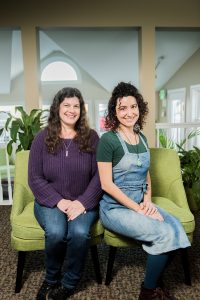Four years ago, I knocked on a nondescript office door tucked away in the basement of a brick building. There was no sign and I hoped I was in the right place. I was newly pregnant, and making a first-time visit to my certified professional midwives (CPMs), or midwives trained specifically to support out-of-hospital birth.

I’d given birth years earlier at a reputable hospital in Baltimore County. But I found the birth of my daughter to be forceful and manipulated, and it had left me with severe pain for many months. I had always known that if I ever gave birth again it would be in my home with trained midwives by my side. But I didn’t yet realize that to find care, I would have to dig for options.
Home birth was, and still isn’t, considered a sound option by many. It is not a societal norm to give birth outside of a hospital environment, and while studies have routinely shown the safety of home birth in low-risk pregnancies, providing women that option across the U.S. has been a work in progress. In response to what many see as restrictive hospital practices, like early inductions, forcing women to labor on their backs, or other unnecessary interventions, home birth rates have been steadily rising anyway. Along with the increase in women who desire more birthing options, there is a need for trained and licensed care providers who can attend them.
In my search, I reached out to acquaintances who were active in Baltimore’s birth community. Through those connections, I located a team of home birth midwives who came highly recommended. I soon found them to be professional and dedicated. To my surprise, our visits lasted an hour and we discussed everything from my diet to how I was feeling emotionally. In spite of the quality of care, I learned at that first meeting that my midwives were not yet licensed. Maryland was one of a handful of states that did not yet permit CPMs to practice legally.
My son was born at home that June after a supported and empowering delivery. The following year, in May 2015, the bill that would legalize home birth midwives passed, meaning women seeking the care of CPMs wouldn’t have to search so hard to find them. It also meant that CPMs, working to serve families desiring the option of home birth, would be protected by law.
“A group of families came forward in 2011 and put forward the first version of the bill, which tanked very quickly,” midwife Alexa Richardson told me. “But the next year we came back better organized.”
Still, it would be three more years before the bill was passed. For the legislation to even be considered, there was a lot of education about the CPM credentials that needed to happen across many groups of people.
Through crowdfunding efforts, enough money was eventually raised to hire a top lobbying firm. After the bill passed, then came the process of making regulations. A committee was created, which Richardson chairs, and it started meeting regularly. Ultimately, the adopted requirements place Maryland CPMs among the most qualified in the country. In fact, the American Congress of Obstetricians and Gynecologists (ACOG) issued a memo in 2017 stating that Maryland is one of only five states whose level of training the organization supports.
Richardson and her practice partner Deanna Kopf were among the first in a group of seven midwives in the state to be registered. In fact, they are numbers one and two, they told me when we sat down together in their office space in downtown Catonsville, which opened last year.
Inside is everything you’d expect a midwife’s office to be: It is both welcoming and serene with comfortable couches, tea and even a drawer full of hand-knitted breasts that are used for the breastfeeding classes that take place there. But unlike the office where I had seen midwives four years prior, this one was complete with signage, at both the front and back entrances, that proudly announces the business name: Birthwise Midwifery.
The visibility of their practice, and others like it, is important. CPM businesses can now be found via a Google or Facebook search, or even a walk through the neighborhood. “We’ve had people walk in off the street who saw our sign and were like, ‘oh my gosh, there’s midwives here!’” Kopf says.
Aside from high standards, the legalization also means better communication between CPMs and hospital staff in the case of a hospital transfer: Information can easily be relayed and midwives are included as a partner in the process. Still, Richardson says news about the licensure will take time to spread to all of the providers in Maryland. “We’re doing rounds at the University of Maryland soon, so that’s an opportunity to talk to the whole staff about home birth, and home birth transfers and how we can all work together to make it a good experience for women,” she says. “We’ve also had a couple meetings with St. Joe’s. They’ve been awesome.”
There are other things Richardson and Kopf still want to accomplish. Being able to serve mothers who want a vaginal delivery after already delivering one child by cesarean section, a negotiation that got slashed during legislation, is something they are committed to fighting for.
“What the data tells us is that the risk (of dangerous complications) is so low, that it’s similar to having many other very uncommon obstetric emergencies which occur so infrequently that it doesn’t make sense, at the end of the day, to limit all women’s abilities to choose the kind of setting they want to be in, and the kind of care that they want to have based on such a tiny number,” Richardson says.
For Richardson and Kopf, the most important aspect of the legalization is that women can make more informed decisions about their own bodies and care. While they are thrilled about their practice and visibility, this is “about people being able to access the care that they want with fewer barriers,” Richardson says. “And they have that access now.”









